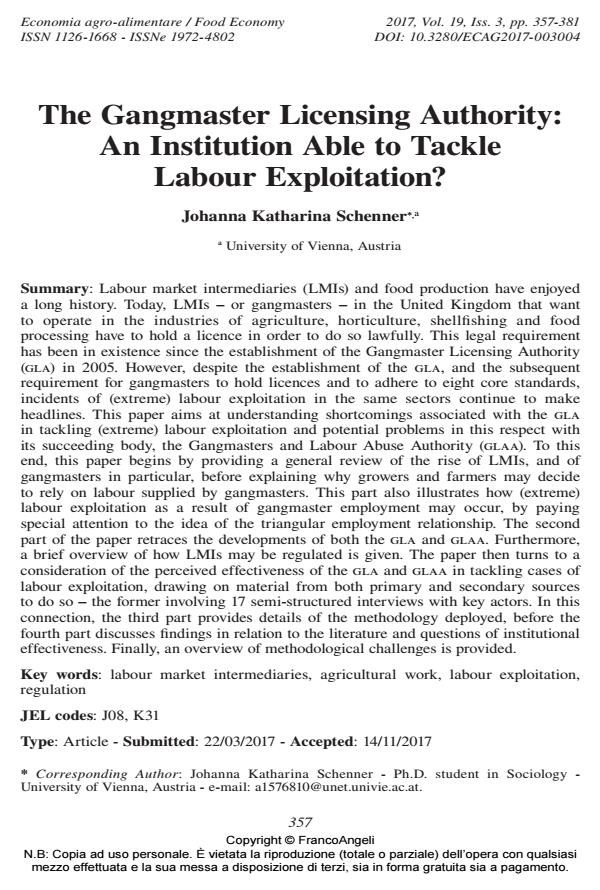The Gangmaster Licensing Authority: An Institution Able to Tackle Labour Exploitation?
Journal title ECONOMIA AGRO-ALIMENTARE
Author/s Johanna Katharina Schenner
Publishing Year 2017 Issue 2017/3
Language English Pages 25 P. 357-381 File size 181 KB
DOI 10.3280/ECAG2017-003004
DOI is like a bar code for intellectual property: to have more infomation
click here
Below, you can see the article first page
If you want to buy this article in PDF format, you can do it, following the instructions to buy download credits

FrancoAngeli is member of Publishers International Linking Association, Inc (PILA), a not-for-profit association which run the CrossRef service enabling links to and from online scholarly content.
Labour market intermediaries (LMIs) and food production have enjoyed a long history. Today, LMIs - or gangmasters - in the United Kingdom that want to operate in the industries of agriculture, horticulture, shellfishing and food processing have to hold a licence in order to do so lawfully. This legal requirement has been in existence since the establishment of the Gangmaster Licensing Authority (gla) in 2005. However, despite the establishment of the gla, and the subsequent requirement for gangmasters to hold licences and to adhere to eight core standards, incidents of (extreme) labour exploitation in the same sectors continue to make headlines. This paper aims at understanding shortcomings associated with the gla in tackling (extreme) labour exploitation and potential problems in this respect with its succeeding body, the Gangmasters and Labour Abuse Authority (glaa). To this end, this paper begins by providing a general review of the rise of LMIs, and of gangmasters in particular, before explaining why growers and farmers may decide to rely on labour supplied by gangmasters. This part also illustrates how (extreme) labour exploitation as a result of gangmaster employment may occur, by paying special attention to the idea of the triangular employment relationship. The second part of the paper retraces the developments of both the gla and glaa. Furthermore, a brief overview of how LMIs may be regulated is given. The paper then turns to a consideration of the perceived effectiveness of the gla and glaa in tackling cases of labour exploitation, drawing on material from both primary and secondary sources to do so - the former involving 17 semi-structured interviews with key actors. In this connection, the third part provides details of the methodology deployed, before the fourth part discusses findings in relation to the literature and questions of institutional effectiveness. Finally, an overview of methodological challenges is provided.
Keywords: Labour market intermediaries, agricultural work, labour exploitation, regulation
Jel codes: J08, K31
- A systematic literature review of modern slavery in supply chain management: State of the art, framework development and research opportunities Vanja Strand, Maryam Lotfi, Anthony Flynn, Helen Walker, in Journal of Cleaner Production 140301/2024 pp.140301
DOI: 10.1016/j.jclepro.2023.140301 - The Governance of the Horticultural Supply Chain in the United Kingdom: A Source of Forced Labour? Johanna Katharina Schenner, in ECONOMIA AGRO-ALIMENTARE 1/2018 pp.29
DOI: 10.3280/ECAG2018-001003 - Decent work for migrants? Examining the impacts of the UK frameworks of gangmasters legislation and modern slavery on working standards for irregularly present migrants Elspeth Guild, Anita Magdalena Barylska, in Global Public Policy and Governance /2021 pp.279
DOI: 10.1007/s43508-021-00015-w
Johanna Katharina Schenner, The Gangmaster Licensing Authority: An Institution Able to Tackle Labour Exploitation? in "ECONOMIA AGRO-ALIMENTARE" 3/2017, pp 357-381, DOI: 10.3280/ECAG2017-003004